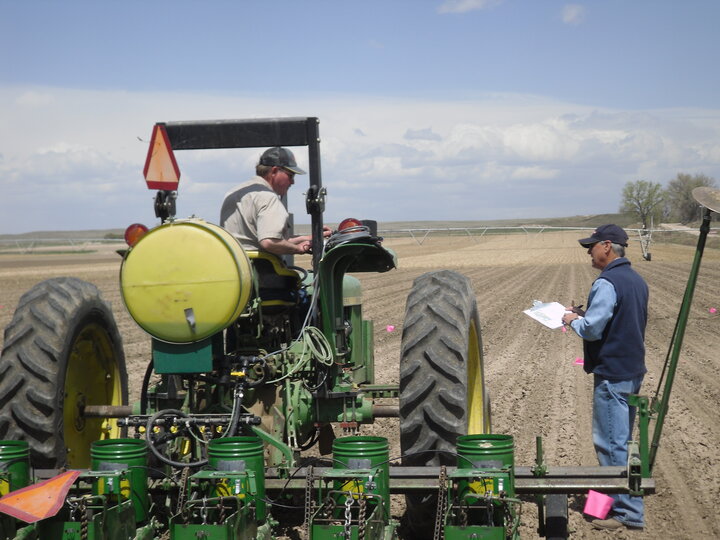Soil Scientist Gary Hergert Retires after 40 Years
July 15, 2015
To call Gary Hergert's four decades of soil and crop nutrient research ground-breaking might be a weak pun. But it isn't an exaggeration.

Hergert's research for the University of Nebraska-Lincoln Institute of Agriculture and Natural Resources helped lay the foundation for UNL's nitrogen algorithm for corn — a basic, yet flexible, formula that helps a farmer decide how much nitrogen fertilizer to apply.
Hergert retired June 30 from his position as extension soil and nutrient management specialist and professor of agronomy at IANR. He has been based at UNL's Panhandle Research and Extension Center for the past 11 years, and before that had been at the West Central Research and Extension Center for nearly 30 years.The nitrogen algorithm, established in the mid-1980s, is used to calculate a recommended rate of nitrogen fertilizer for each field. It factors in the field's expected yield, soil organic matter, soil residual nitrate levels, and other nitrogen sources, such as irrigation water, manure and prior legume crops.
The formula is published in the Nebraska Extension publication, "Fertilizer Suggestions for Corn." Hergert is co-author with Nebraska Extension Soil Specialists Charles A. Shapiro, Richard B. Ferguson and Charles S. Wortmann and Professor of Agronomy and Horticulture Daniel T. Walters.
See more on Hergert's research, work in Nebraska Extension, and what he sees in agriculture's future.
"Dr. Hergert took the lead to summarize 81 site-years of data and develop the process we use to make nitrogen recommendations for corn," Shapiro said. "The process is over 20 years old and has been verified as effective by research conducted under high-yielding conditions."
"The UNL nitrogen recommendation procedure is used by NRCS in their documents, and is recommended by the various natural resources districts that have nitrogen management plans."Added Ferguson: "The current soil-test-based UNL N recommendation algorithm for corn has been shown through comparison to other methods to be among the most accurate methods to predict an optimum N rate. This tool has been one of the means by which nitrogen use efficiency has steadily improved over the past 20 years in Nebraska."
Since it was first published, additional research has helped tweak the algorithm to factor in higher yields due to better corn genetics, fertilizer cost and timing of applications. But the basic formula has remained the same, Hergert said.The amount of nitrogen fertilizer sold in Nebraska has decreased since the 1980s, he said, while corn yields have steadily increased.
Growing up on a farm in northeastern Colorado, Hergert was a self-described shy kid who liked chemistry. He received a bachelor's degree in agronomy at Colorado State University in 1967 and a master's degree from CSU in 1970, also in agronomy. He served in Air Force National Guard from 1968-74.In 1969 CSU hired Hergert to run its soil testing lab. In 1971 Cornell University at Ithaca, N.Y., offered an assistantship, and Hergert moved east. His doctoral dissertation involved the effects of dairy manure on soil phosphorus loss. After receiving a doctorate in agronomy from Cornell in 1975, Hergert was hired as a soil nutrient research and extension specialist at UNL's West Central Research and Education Center at North Platte.
From 1994 to 2004 Hergert moved to administration, as director at the West Central Research and Extension Center, where he oversaw a renovation project. After moving to the Panhandle Center, he again stepped away from his soils specialist role in 2013-14 to fill in as interim director, which again included overseeing a building renovation project.
Moving Nitrogen Research to Field Practice
"During a lot of my career, my research concerned what I call chasing nitrate: quantifying nitrate leaching, conducting extension by educating farmers on better nitrogen management to decrease nitrate losses," Hergert said. Research showed that the most leaching occurred in the fall and winter. "I found that farmers had to adjust the rate and timing of their fertilizer applications."
Hergert's primary research focus has been nitrogen management in irrigated and dryland crops. But he has also worked on numerous other projects, including- fertility of a number of major and minor crops;
- effects of limited irrigation and no-till systems;
- comparisons of nitrogen rate recommendations from commercial soil labs to UNL recommendations;
- ecofallow starter and nitrogen rates; and
- studies into zinc and other micronutrients such as iron.
As for himself, Hergert said he plans to be a "very active emeriti," finishing up some projects that are in the works. "When my wife (Doylene) doesn't have me traveling, I plan to work on publications," he said.
David OstdiekCommunications/Technology Specialist, Panhandle REC
